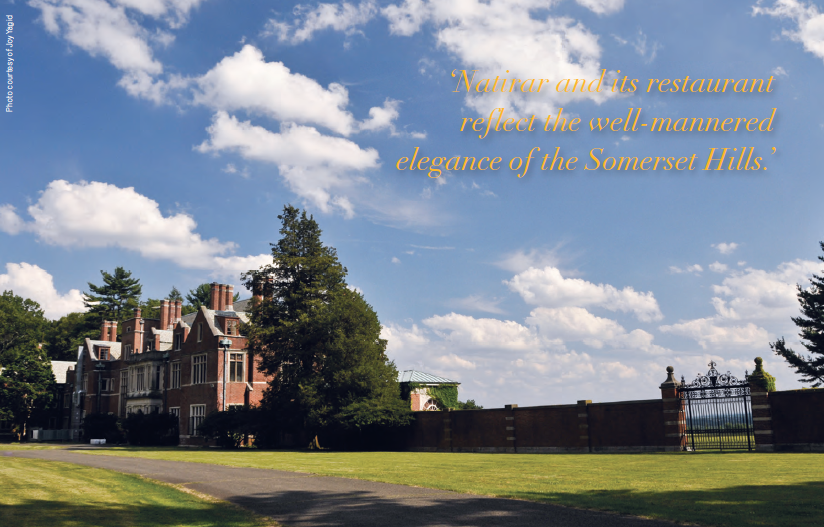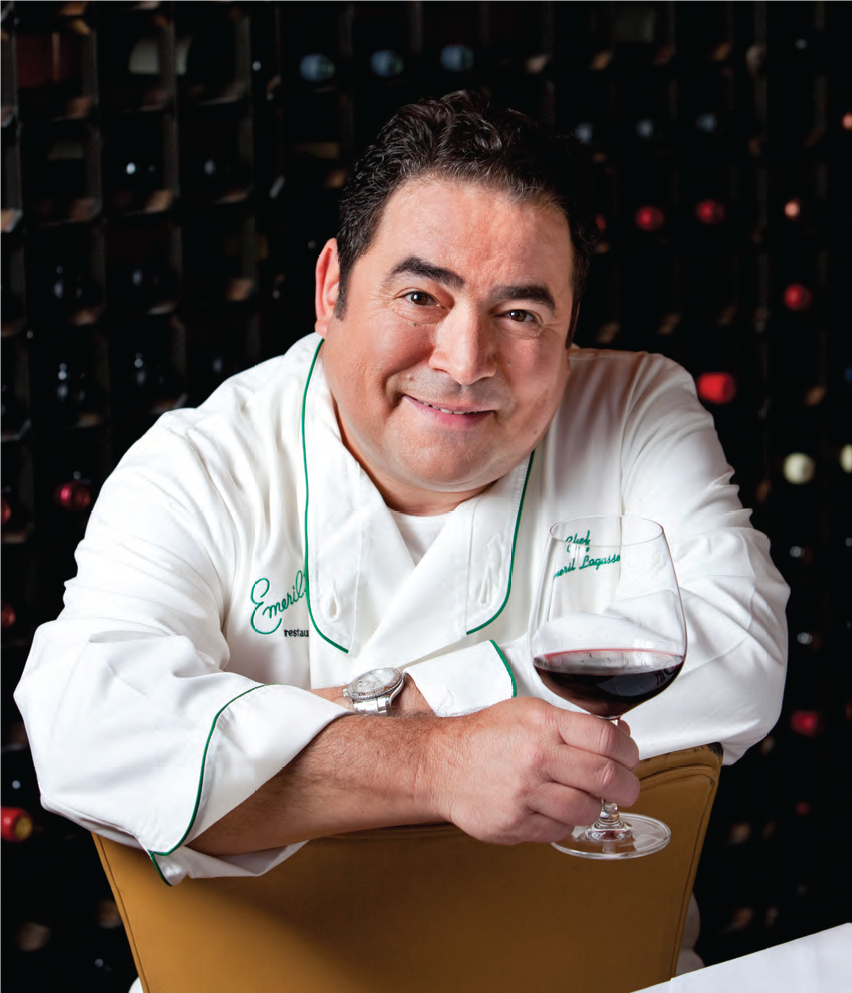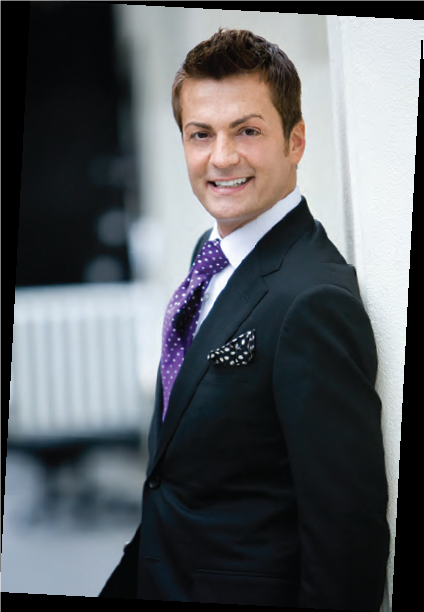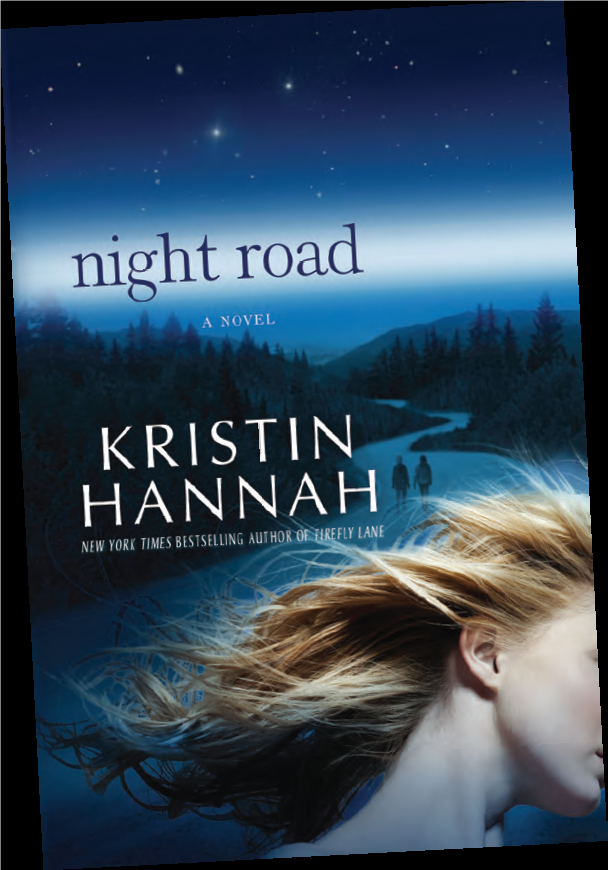‘Since you’re playing lord or lady of the manor, order the entrée-size as your appetizer and practice reveling.’
The long and winding road that drops you at the entrance to Ninety Acres might justify the traction of Hummer’s H2, or the agility of a basic Jeep, or the diminutive size of a Mini Cooper to best navigate its narrow confines. But, frankly, I was thinking “Bentley” as we approached the restored carriage house in Peapack- Gladstone that has been transformed into a destination restaurant on the 500-acre estate called Natirar. A Rolls would be too obvious. As the valet opened a door of our SUV, protecting us with an umbrella on this monsooning night, I wanted to ask, “How many Bentleys do you park a month?” I didn’t. I wanted to be inside, cloistered by the expanses of stone and wood that are brightened by glass and warmed by leather and copper. After being seated and gazing about, I sensed an Arts & Crafts attitude about the place. Albeit Arts & Crafts on a soaring, grandiose scale. To the right of the entrance is a bar with tavern room dining; to the left is the main dining space. Wander around and you’ll come across an open kitchen where you can watch pizzas shoveled into, then taken out of, a wood-fired oven— and maybe even the tucked-away Cognac Room, where parties who’ve properly reserved can dabble in a small plates scene.
If it all seems mighty aristocratic, remember: You are only in the carriage house. The original estate of the Ladds—Walter and Kate—began to take shape in the first decade of the 20th century. The couple acquired parcels eventually totaling 1,000 acres in Peapack-Gladstone, Far Hills and Bedminster, the core of the Somerset Hills. They built a 33,000-square-foot main home in the Tudor style. In clever tribute, they named the whole shebang the reverse of the river that runs through it. The anagram of the Raritan stuck, even after it was sold in the 1980s to the Royal Family of Morocco. As the new century dawned, local resident Bob Wojtowicz started to realize his dream of turning Natirar from historic estate to luxury resort. His plans caught the interest of Sir Richard Branson of the Virgin Group, and dovetailed nicely with the goals of Somerset County. It became a Wojtowicz- Branson-Somerset County public-private partnership, and today Natirar itself reflects that arrangement. There’s a private club, offering trips abroad, wine tastings and sports. To come will be a hotel and spa.
Right now, open to all, is Ninety Acres, the restaurant. That is the domain of chef David Felton, who mines New Jersey for ingredients that shape his menus and add to what is grown on Natirar’s farm and raised in its pastures and pens. It’s a concept not unlike Blue Hill at Stone Barns in upstate New York, though there’s a very, very Somerset Hills-y feel to the scene. That is to say, the plates at Ninety Acres have a contemporary classic esthetic. Felton, formerly chef at the Pluckemin Inn, doesn’t press at the edges of global trends or push unfamiliar ingredients upon a crowd accustomed to their comforts (and comfort zone). He’s taking it slowly, looking at the concept and the menu as an educational process. For example, on my first visit to Ninety Acres shortly after it opened in December 2009, folks were just testing the poached egg and pork belly starter that now, a year-and-a-half later, is a signature dish scoring universal raves.
This time, we tried a spin-off pizza in which the egg and pork mingle with the heat of chilies and the pungent spark of Gorgonzola and asiago cheeses, mellowed only slightly by a film of fontina. It’s a winner, the pie that Ninety Acres’ fans recommend without hesitation. I’d recommend a terrific pasta dish (whether you try it as a starter or main course) of chewy garganelli and Natirar lamb that’s been slow-braised till it’s practically spoon-ready. What makes it lovable is the tingle of mint pesto coupled with the richness of meaty fava beans and maitakes, my personal favorite all-luxe mushroom. Don’t stint on this one; since you’re playing lord or lady of the manor, order the entrée-size as your appetizer and practice reveling. I wanted to revel in the terrine of duck breast and foie gras, but found it too one-dimensional. There was a dab of aged sherry, snips of blood orange and a sprinkle of pistachio on the plate, but nothing to add vigor to the seriously buttery taste and texture of the terrine. More satisfying was a petite pot of French lentils bolstered by a true darling of a stew of spring vegetables. Here, Felton nudges diners by adding Valley Shepherd Creamery’s “Nettlesome” cheese to the mix, topping it all off with a spray of lemon oil. The mixed milk cheese flecked with nettles and the intensely citrusy oil make a dish with an inherently gentle soul provocative. That’s good cooking.
FULL SERVICE The floor crew at Ninety Acres has come into its own since its rocky start in late 2009/early 2010. I recall a dinner at which a few members of 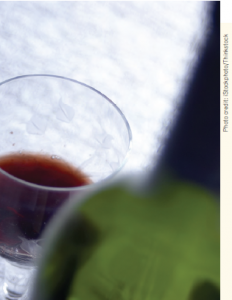 the service staff debated right in front of us which table got the plates they had in hand; politely trying to wrangle silverware as our food grew cold; and having to beg refills of our wine from a bottle set at a distance. The worst offenders? A couple of captains who openly complained about being short-staffed. None of that happened during a recent visit, when our meal’s delivery was well-orchestrated and servers attentive (if still prone to interrupting conversation with the always-awkward, “How is everything?”). The wine list has grown in scope and depth, the handiwork of sommelier Brooke Sabel. Though the by-the-glass program could offer more boutique selections, there’s a tie to the cuisine that shows thought. Clearly, Ninety Acres is in this game for the long haul.
the service staff debated right in front of us which table got the plates they had in hand; politely trying to wrangle silverware as our food grew cold; and having to beg refills of our wine from a bottle set at a distance. The worst offenders? A couple of captains who openly complained about being short-staffed. None of that happened during a recent visit, when our meal’s delivery was well-orchestrated and servers attentive (if still prone to interrupting conversation with the always-awkward, “How is everything?”). The wine list has grown in scope and depth, the handiwork of sommelier Brooke Sabel. Though the by-the-glass program could offer more boutique selections, there’s a tie to the cuisine that shows thought. Clearly, Ninety Acres is in this game for the long haul.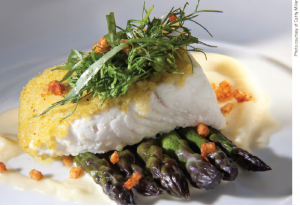
Perhaps that’s where Felton would be taking the entrées. Don’t misunderstand: Once settled into the posh, so very comfortable dining spaces of Ninety Acres, even completely unadorned basics might do you just fine. But I know Felton’s cooking can offer head-turning surprises—quirks that complement and even elicit uncontainable exclamations from diners. I wasn’t getting a lot of that here. Yet. Next on the table was a top-notch bone-in strip steak, panroasted to a T and sided with a couple of small grilled portobellos. A quick lick of steak sauce, and that’s all the kitchen delivered. I wanted to taste a feisty crust of seasoning on the steak and a counterpoint to the portobellos, which, after all, have a similar beefy appeal as the meat. We ordered a couple of sides (at $9 apiece)—a strapping plate of earthy braised greens pocked with bacon and made bold by mustard and ultra-haute mashed potatoes ordered with olive oil but served instead with butter. I’d suggest doing the same. I’d also suggest—should it be on tap as the menu changes with the seasons and evolves—the cod with a pitch-perfect Meyer lemon-lobster sauce. It’s Felton at his peak, respecting the integrity of the cod by enhancing its flavor, but without overwhelming it by adding both contrasting acidity and rich, dense, naturally buttery shellfish. A flourish of royal trumpet mushrooms, sunchokes and runner beans ringing the plate made this one exuberant, defining dish. Very small Barnegat Light scallops were planned as the focus of an entrée that didn’t quite come together. Partnered with the overcooked scallops were roasted beets, a small beef short rib and a smattering of  horseradish. At a nearby table, a party of smartly dressed adults and children were doing Ninety Acres’ Saturday night special of prime rib, exchanging grins and wielding their steak knives with admirable skill. Food for thought. Finales here follow suit, meaning they are neither splashy nor curiosities, but takes on classic confections. My favorite was the mascarpone cheesecake that may have skirted pledges to seasonality with roasted pear and rosemary honey as accents, but charmed with pure deliciousness. The crust of the maple custard pie was short of perfectly flaky, but the tout to local eggs and the fledgling sugaring industry can’t be shortchanged. There’s also a chocolate torte paired with chocolate-jalapeno ice cream that shouldn’t put off anyone who fears the heat of chilies. It’s a barely-there presence, that jalapeno, making the dessert all about chocolate. Ninety Acres is all about the New Jersey the jokesters ignore—the New Jersey, mind you, we’re grateful they ignore. It’s been described by those who don’t live here as an oasis. But it’s not. Natirar and its restaurant reflect the well-mannered elegance of the Somerset Hills. It’s going to be a pleasure to watch Ninety Acres and its surrounding communities explore new culinary horizons together.
horseradish. At a nearby table, a party of smartly dressed adults and children were doing Ninety Acres’ Saturday night special of prime rib, exchanging grins and wielding their steak knives with admirable skill. Food for thought. Finales here follow suit, meaning they are neither splashy nor curiosities, but takes on classic confections. My favorite was the mascarpone cheesecake that may have skirted pledges to seasonality with roasted pear and rosemary honey as accents, but charmed with pure deliciousness. The crust of the maple custard pie was short of perfectly flaky, but the tout to local eggs and the fledgling sugaring industry can’t be shortchanged. There’s also a chocolate torte paired with chocolate-jalapeno ice cream that shouldn’t put off anyone who fears the heat of chilies. It’s a barely-there presence, that jalapeno, making the dessert all about chocolate. Ninety Acres is all about the New Jersey the jokesters ignore—the New Jersey, mind you, we’re grateful they ignore. It’s been described by those who don’t live here as an oasis. But it’s not. Natirar and its restaurant reflect the well-mannered elegance of the Somerset Hills. It’s going to be a pleasure to watch Ninety Acres and its surrounding communities explore new culinary horizons together.

Editor’s Note: Andy Clurfield is a former editor of Zagat New Jersey. The longtime food critic for the Asbury Park Press also has been published in Gourmet, Saveur and Town & Country, and on epicurious.com.
Dress like a tourist. Eat like a local. The Ultimate Insider’s Jersey Shore Dining Guide.
Have you ever driven past one of those mysterious local eateries along the New Jersey coast and wondered aloud, “You think that place is any good?” Well,  wonder no more. We have removed the guesswork and narrowed the search. Presented here, for the very first time anywhere (that we known of anyway), is the bona fide dining guide to those neighborhood joints between Sandy Hook and Pt. Pleasant that locals swear by. Sure, you could peck away on the Internet and read all those planted reviews. Save yourself the trouble. The 60 “Shore Things” on this list are the real deal, with raves from real customers—trust us. Expect plenty of atmosphere, not too much ambiance. A few accept reservations, but most do not. Bon Appétit. EDGE
wonder no more. We have removed the guesswork and narrowed the search. Presented here, for the very first time anywhere (that we known of anyway), is the bona fide dining guide to those neighborhood joints between Sandy Hook and Pt. Pleasant that locals swear by. Sure, you could peck away on the Internet and read all those planted reviews. Save yourself the trouble. The 60 “Shore Things” on this list are the real deal, with raves from real customers—trust us. Expect plenty of atmosphere, not too much ambiance. A few accept reservations, but most do not. Bon Appétit. EDGE
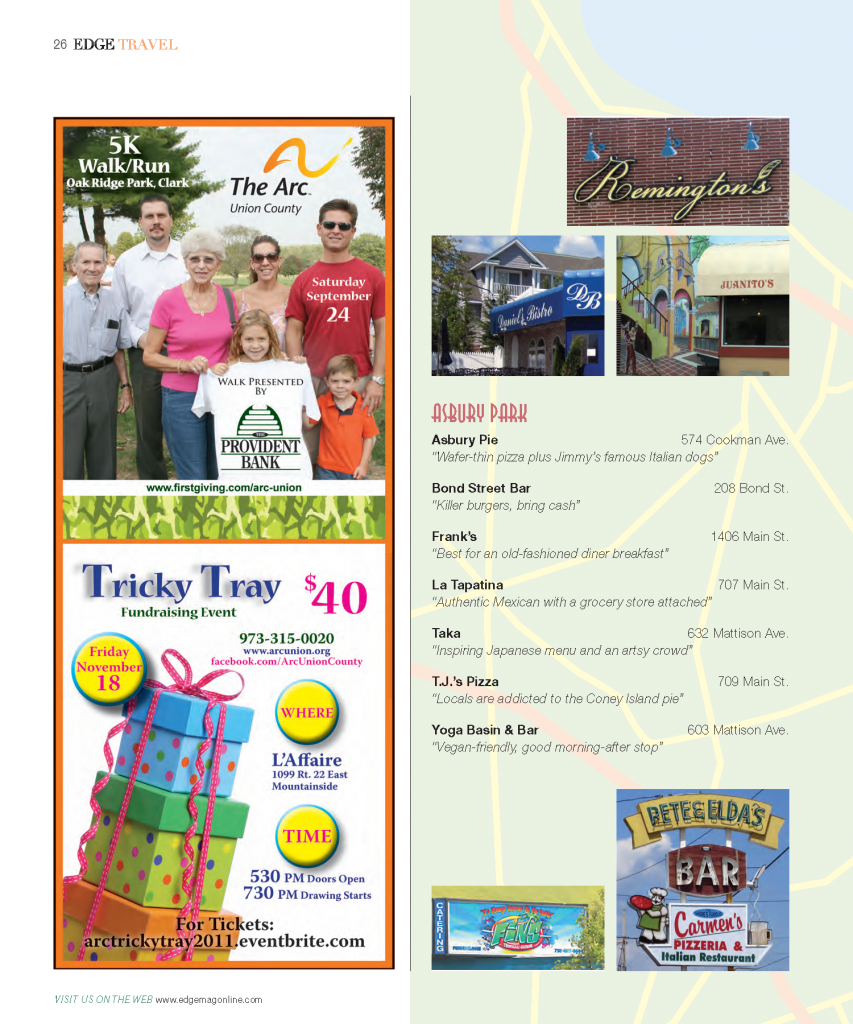



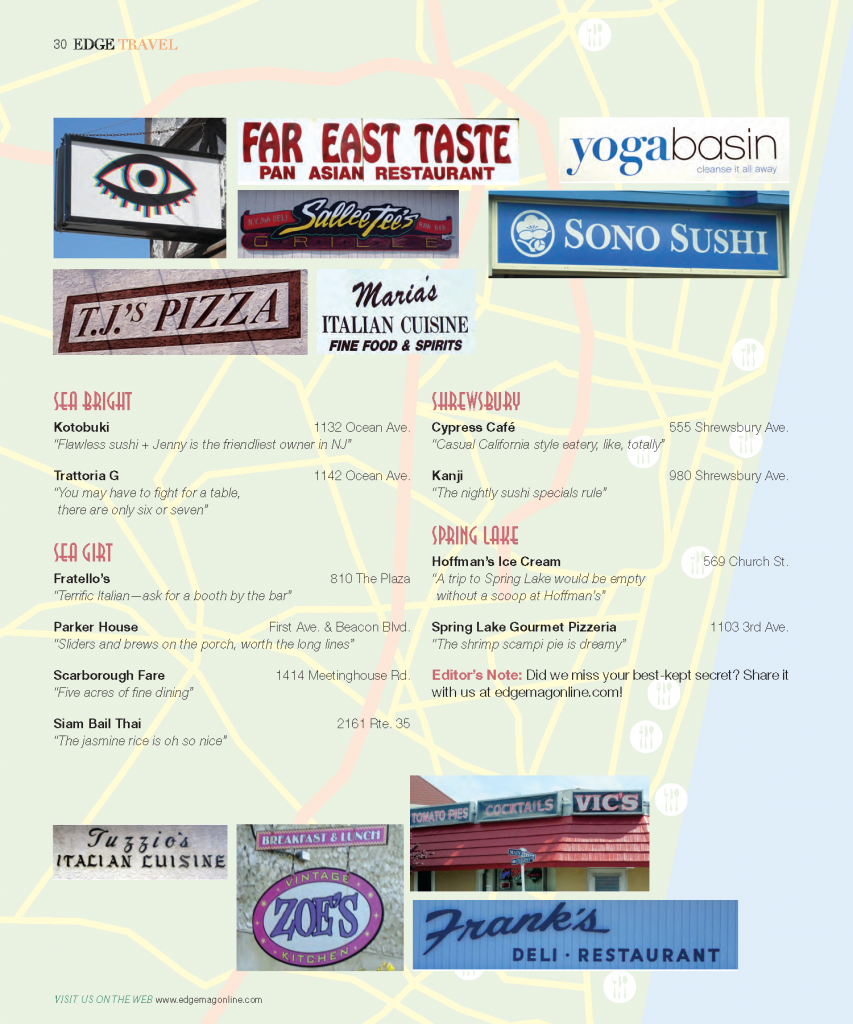
Internationally acclaimed chef, bestselling author, beloved TV personality, retail superstar— there isn’t much Emeril Lagasse hasn’t done in the culinary world. So it might surprise you to know that among his 12 award-winning restaurants there has never been an Italian one. Until now. This June, Lagasse opens Emeril’s Italian Table at a casino near you—the Sands Casino Resort Bethlehem to be specific, just over an hour away, a straight shot out Rte. 78. It will be his third eatery at the Sands, joining Emeril’s Chop House and Burgers and More (aka BAM). Emeril’s Italian Table features the chef’s creative takes on the rustic Italian cuisine he grew up on, as well as classic meat, fish and vegetarian dishes, wood-oven pizzas and artisanal cheeses. Diners will get to experience the cooking process up close thanks to a large window into the kitchen. EDGE editor Mark Stewart tracked down Lagasse as he put the finishing touches on his latest creation.
EDGE: Everything you do is accompanied with such high expectations now—do you experience more pressure or anxiety when you are creating a restaurant concept, or after the restaurant opens?
EL: Opening a restaurant is tough but I love it. With Emeril’s Italian Table the feeling is definitely excitement. I’ve got a great team that has been part of my organization since the very beginning. We all work hard and put a lot of energy into the planning and the menu, crafting the right look and feel of the restaurant. Our style of service and hospitality originates from my restaurants in New Orleans and is a huge part of our culture and the Emeril’s experience. In the end, we’re in the business of making people happy.
EDGE: What signature touches will veteran diners recognize at your new place in the Sands?
EL: When I opened my first restaurant, Emeril’s, in New Orleans, we really wanted to take down the wall between the kitchen and the dining room. If you visit today, there’s really no barrier between the kitchen and dining room—you can see us at work and we can see who’s dining, and make sure everything is going smoothly out in the front of the house. Emeril’s Table will include an antipasto bar and a food bar so you get that same experience and interaction up close. The food bar is still one of the hottest seats in the house.
EDGE: You opened Emeril’s Chop House at the Sands a couple of years back, and people swear by it. What goes into making a first-rate chop house—from the menu to service to the atmosphere?

EL: This is our only Chop House, so the concept here is a steakhouse with a little twist on the usual standards – chops, steaks, free-range chicken, seasonal fish, lobster and there’s also some Creole-inspired dishes. We wanted to keep a little sensibility of an American steakhouse, except more open and modern. It’s a really inviting and comfortable atmosphere with great food and great service. Each one of my restaurants has its own personality. My belief is that a restaurant must have heart, soul, and always provide a great customer experience. Great food, great wines, and great service—that’s our philosophy regardless of location.
EDGE: In the pantheon of “celebrity chefs” I think of you as approaching things with a rock-star attitude. Does that come from the days when you were considering a career in music? Are you kind of living both lives at the same time?
EL: Well, I grew up doing both and I still love both. Music was and still is another big passion for me. I was in a local band and played the drums in high school. I was even offered a scholarship to music school, but I decided instead to enroll in culinary school at Johnson & Wales University. I have been fortunate enough to overlap the two along the road.
EDGE: When was that moment when you said to yourself Hey, I’m REALLY good at what I do!
EL: I was probably 8 or 9 years old when I realized that I might want to cook and be a chef one day.
EDGE: You are a proponent of eating local produce, and obviously New Jersey has a lot to offer in that respect. What do you feel is the #1 most misunderstood or underrated vegetable?
EL: Kale. I love cooking with fresh greens, lettuces and kale—whether it’s in a soup or sautéed and served with pasta and clams. Our menus generally rotate about three or four times a year. As we transition into summer we’ll make a few menu changes for the season and incorporate the local summer corn and tomatoes and you’ll really see the seasonal influences.
EDGE: This is our Mind Your Manors issue—manors referring to homes. What are some of the mistakes home chefs tend to make when they try to prepare big, bold cuts of meat themselves?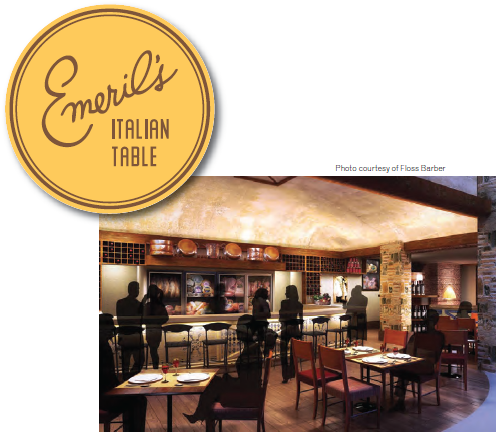
EL: Under-seasoning. Salt and pepper are a cook’s best tool. Sometimes people are afraid to season, but that’s the secret to a great steak—salt, pepper and maybe a little cayenne or essence. Sprinkle a little more salt at the end, and maybe a drizzle of olive oil and a squeeze of fresh lemon.
EDGE: Can you make a truly great steak at home without a commercial kitchen?
EL: A cast-iron skillet, grill pan, or a gas or charcoal outdoor grill are all you need. A lot of people are afraid of under cooking meat, so a good meat thermometer is a smart investment.
EDGE: How has home cooking—from your family background—expressed itself in your creations over the years? How often do you reach back 40 or 50 years for a little inspiration?
EL: Growing up, I was always interested in food from a very young age. My mom Miss Hilda, who is Portuguese and French Canadian, and my dad, Mr. John, were a huge influence on my life. I learned a great deal from my mom. She taught me how to cook and that started my passion for the culinary arts. I also worked at a local Portuguese bakery while in school. I learned the art of making breads, pastries and cakes. Everything I learned early on shows up in some way in my restaurants.
EDGE: What did you learn from baking?
EL: What I learned is one of the most important foundations of my restaurants: make everything from scratch. Bread, pasta, Andouille sausage, Worcestershire sauce, ice creams, sauce—you name it.
EDGE: No shortcuts?
EL: No. There are no shortcuts.
Editor’s Note: BAM! EDGE readers can Cook with Emeril. Go to edgemagonline.com for an Opening Night recipe from Emeril’s Italian Table.
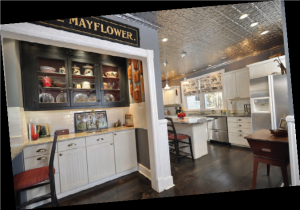 It’s that time of year again. For Sale signs are popping up everywhere you look. And once again, it’s a buyer’s market this summer. House hunters can afford to be picky, and they should be. Holding out for something extraordinary—price wise, property-wise or both—is half the fun of the hunt! When’s the best time to make your move? When the stars align and you walk into a home with some feature that blows away everything else you’ve seen. A charming front porch. A killer kitchen. The master bath of your dreams. A suburban oasis in the backyard. There are a lot of names for the house that speaks to you in that deep, intimate way. We call it the Home Run.
It’s that time of year again. For Sale signs are popping up everywhere you look. And once again, it’s a buyer’s market this summer. House hunters can afford to be picky, and they should be. Holding out for something extraordinary—price wise, property-wise or both—is half the fun of the hunt! When’s the best time to make your move? When the stars align and you walk into a home with some feature that blows away everything else you’ve seen. A charming front porch. A killer kitchen. The master bath of your dreams. A suburban oasis in the backyard. There are a lot of names for the house that speaks to you in that deep, intimate way. We call it the Home Run.
RECIPE FOR SUCCESS • Westfield The owners of this 1880s bungalow pulled off the impossible—a thoroughly m

Photo courtesy of Shari Holtzman
odern kitchen while maintaining the home’s Arts & Crafts charm and functionality.
VISION IN WHITE • Westfield “Heavenly” isn’t a word one uses to describe a bathroom, but in this case it’s totally appropriate. That claw-foot tub is an updated take on a Victorian classic.

Photo courtesy of Frank Isoldi
FRONT AND CENTER • Westfield Colonial Revival architecture can be kind of a yawnfest, but the curb appeal of this unusual 1920s eye-opener carries through all 12 rooms.

Photo courtesy of Irene Katz
RULE THE POOL • Scotch Plains Every homebuyer needs a tipping point. After touring the interior of this suburban contemporary, it’s the pool that says “Jump right in!”

Photo courtesy of Joan Kylish
CLOCK WATCHER • North Plainfield Technically, it would be incorrect to call this magnificent 1911 converted gatehouse a “timeless beauty.” No winding required.
BEAM ME UP • Westfield Vaulted ceilings, leaded glass, original wood planking, stone fireplaces—we surrender! It’s another gatehouse, this one constructed in Wychwood circa 1928.

Photo courtesy of Sherrie Natko
Editor’s Note: Each of these properties was on the market as of May 15, 2011. For more information contact the listing brokers. All have 908 area codes: Shari Holtzman 233–5555 ext. 210; Frank Isoldi 233–5555 ext. 202; Irene Katz 301–2892; Joan Kylish 301–2043; Sherrie Natko 233–3014.
Nothing says more about you than the interior of your home. Yet so often, we look at our surroundings and think, Is this really me? At moments like these, you may want to consider professional help. A shrink? Probably not. A designer? Most definitely. Indeed, sometimes the task of minding your manor is best left to someone with a keen and objective eye. Enter Clodagh, a legend in the design world who has worked in 90 countries and lent her talents to everything from cosmetics packaging to major hotels. Her inspirational and lifeenhancing designs feature sustainable materials and embrace Feng Shui, Chromotheraphy and Biophilia to create a signature look, structure and flow. Sarah Rossbach, a friend and colleague, connected with Clodagh in her Manhattan offices. There she manages the Clodagh Collection—an online showroom of home furnishings and accessories—and Clodagh Design, her design services studio.
EDGE: How do you feel about the old saying, Neer make friends with your interior decorator?
Clodagh: It’s the absolute opposite. The first large job I got, my client looked me up and down and said, “Come out to dinner.” Other designers had told me, “Never go out to dinner with your client!” But my client said, “I will never hire anyone for anything unless I can sit down at the dinner table and have a conversation and communicate well with them.” And that was a very wise thing.
EDGE: So what kind of expectations should each person have when they start working with an interior designer?
Clodagh: You should expect a designer to work as a travel guide to your own life. Although you may not know it, everybody possesses his or her own innate good taste. The role of a designer is to help you explore how you want to live—how you want to actualize your life in your home, how you want to see your children in a play space, so they can make a mess and have fun doing it. When working with me, you should expect to explore your lifestyle and discuss what you expect in your own home. And when I get those down into what I call a program, then I can start to design the project, and get it built and finished. I approach design using the four C’s: Contemplate your space; Cleanse your life of unwanted and unused things; Clarify your goals, needs and desires; and Create a space that is yours at the core.
 EDGE: What is step one when choosing a designer?
EDGE: What is step one when choosing a designer?
Clodagh: The best thing you can do before interviewing designers is to go to a consultant who represents a lot of designers. That person will recommend a match for you. Or you can look at a lot of design magazines and start pulling out photos of what appeals to you, and then find out who designed them. Never analyze it—just know that something appeals to you. Hold on to this visceral reaction to the space. I think the best thing is to look at yourself, your family, your partner and really figure out how you want to live.
EDGE: At what point is the right time to start talking to an interior designer?
Clodagh: As soon as you realize you’ve done enough research yourself and you need some guidance.
EDGE: Is it okay to use a designer you find intimidating or overpowering?
Clodagh: No. Do not use an interior designer who intimidates you. You should never feel afraid to bring something up. Or have to endure a designer flouncing around telling you that you have terrible taste and an object you love “has to go.” At the same time, you do want someone strong, and you need to trust his or her taste. There should be mutual trust. It’s about the conversation. You need to be verbally compatible before you can be visually compatible. Because if you feel any tension, stress or negative reaction, or hidden agenda, it’s not for you. You don’t dictate to them, they don’t dictate to you.
EDGE: What happens when a client won’t part with something god-awful?
Clodagh: Usually the god-awful thing leaves without me having to do anything at all. If it’s been in storage, the client looks at it in the new environment and says, Oh, it doesn’t fit that well.
EDGE: You ask your clients a lot of questions before taking a job. What are the best questions a client asks you— the questions that tell you that the relationship is going to work well?
Clodagh: “Can you help me to live the way I want to live?” or “How can you guide me to have the sort of environment where I can have peace, balance and live harmoniously?” Really, the best thing a client can do for me is describe their ideal lifestyle, and then ask me how I can achieve it for them. And like any good conversation, I interject and suggest. I’m working with a client now who likes working in a really dark office. So I have to balance that darkness with enough light that I feel will be comfortable for him, position his desk properly, add the kind of color that will give the room a boost, and then go with it. And I need to temper his love of darkness with his wife’s love of light.
EDGE: Yin and yang.
Clodagh: Exactly. Another good question people ask is, “How can you do my children’s room?” I find children’s rooms to be over-stuffed and prefabricated in the parents’ mind, with little elephants painted on walls, when actually children are the most artistic creatures in the world. I love children and how their minds work. I install in their rooms chalkboards or dry point boards to use their markers on, so they can enjoy their environment. If it’s a house, I’ll make a room that’s specifically for them. It’s their room where they can make a mess and leave it if they need to—and not feel they have to clean up because Mommy or Daddy is coming. I get the joy that children feel in the spaces I design. I love that they’re empowered.
EDGE: What are the questions a client should listen for from a designer?
Clodagh: A designer should be asking you, “How can I help you live the way you want to live?”
EDGE: That’s a very spiritual approach.
Clodagh: Yes, there’s no such thing as an inanimate object. You’re working with people to achieve a spatial, visual and visceral harmony. And harmony is very hard to quantify. I sometimes tell my clients when they are choosing a chair to close their eyes. Sit in it and close your eyes and feel what’s the sensation. I find most clients focus on the visual. Susan Sontag said, “Sight is the most promiscuous of all the senses.” But in design, our other senses are equally important. So we need to explore all our feelings. For instance, we have a client in Texas who told us she has a very stressed-out life and that soaking every day in a warm tub helped relax her. So we focused a lot of energy and budget on creating an extraordinary bathroom. She brings into this beautiful space flowers and candles, and when she steps into her tub that is her time, where she releases her emotional and physical toxins. It’s a cleanse, where she regains herself.
EDGE: What do you get from creating a home that you don’t get from a corporate job?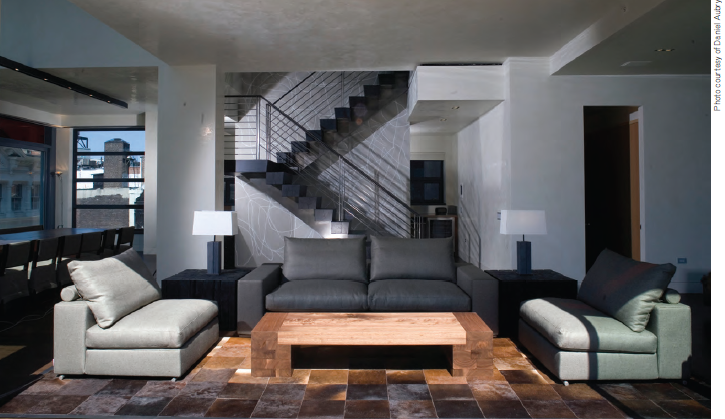
Clodagh: With a home, if the family is happy and comfortable, they disappear. If not, you get telephone calls. With a corporate job, years down the road, people still refer to the design. People working in a large music office I designed 20 years ago still tell me how they love working in that space.
EDGE: What does a great client bring to the experience so you have a wonderful collaboration?
Clodagh: Challenge!
EDGE: In terms of interior design, what is the “shelf life” of a Clodagh job?
Clodagh: I’m having lunch today with someone whose apartment I designed 23 years ago. She and it are still going strong. Some old clients will call and ask me to freshen up my existing design after many years. They’ll invite me to have a look around, and then not allow me to touch anything. Just freshen it up. Maybe new sheets, new drapes, new shades. My feeling is good design should not have a shelf life. I work to create a timeless design.

Photo credit: iStockphoto/Thinkstock
Well, and limit your exposure to toxins like cigarettes and alcohol. But maintaining mental fitness is often off our radar. We go to medical doctors for checkups and tests, but we’re often reluctant to make time to review and change elements in our lives to maintain our mental health. “The mind is a miraculous and delicate thing,” says Rodger Goddard, Ph.D., chief psychologist at Trinitas Regional Medical Center. “It needs our care, protection and nurturance to continue growing throughout our lives.” Fortunately, preserving and enhancing your mental health requires only a few key lifestyle changes and simple strategies. At the top of the list? Managing stress. Stress causes surges in hormones that can damage your body— and your mind. “Stress increases the cortisol level in our brains, causing the destruction of neurons,” says Patricia Neary-Ludmer, Ph.D., a psychologist and director of Trinitas Regional Medical Center’s Family Resource Center in Cranford.
The fight-or-flight surge of adrenaline that occurs when you’re stressed can cause other damage to your brain, too. “When the lower reptilian brain is aroused by excessive stress or anger, higher brain functions tend to decrease or shut down,” Goddard points out. “Stress, anxiety and depression have been shown to decrease intelligence and cognitive skills.” There are a number of lifestyle tweaks that can improve mental acuity and fight off stress, depression and other mental-health issues. Here are some of the most effective:
Eat Smart You already know a healthy diet is essential for improving your overall physical health—but eating the right foods can improve your mental health, too. Fatty foods, especially those with saturated fats, can clog arteries and inhibit blood flow to your brain, explains Neary-Ludmer. To boost your brainpower, “eat foods like fish and nuts, which are commonly referred to as brain foods.” To further boost your brainpower, consider supplementing your diet with antioxidants and vitamins. “Studies show that diets rich in antioxidants—vitamins C, E, B and beta carotene—can help us to maintain good memory and thinking skills,” Goddard says.
Challenge Your Brain Just as your body needs regular strength and cardio training to keep it in optimal shape, your brain needs a good workout to preserve its prowess. Puzzles, animated discussions and memorization exercises can help improve your mental acuity. Goddard suggests asking yourself questions to strengthen your mind. “In particular trying to discover the causes of events and asking ourselves ‘why’ questions can strengthen our mental muscle.” Neary-Ludmer recommends challenging your brain by learning a new language, or even simply trying to write with your non-dominant hand. The payoff in mental prowess will be rich. “The more we exercise our brain and keep it active, the sharper our minds will be,” Goddard says. “Mental dullness and passivity can erode mental sharpness.”
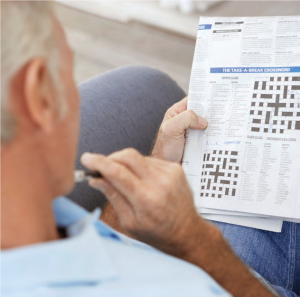
Photo credit: iStockphoto/Thinkstock
Get a Good Workout Exercise isn’t just good for building muscles—it helps build mental acuity, too. “Exercise will increase blood flow to the brain, carrying oxygen and nutrients,” Neary-Ludmer says. A good workout plays a key role in ensuring good mental health. “Physical exercise has been shown to increase brain chemicals that improve memory, reaction speed and creativity,” Goddard adds.
Meditate You don’t have to do a full-on “just say ohm” yoga retreat—but taking a few minutes each day to clear your mind, breathe deeply and relax can have benefits beyond simple stress relief. “Meditation has been shown to increase mental focus, awareness and some thinking skills,” Goddard says.
See the Glass as Half Full Look for ways to increase the amount of fun in your life—whether it’s listening to upbeat music, limiting the amount of time you spend with negative people, or adjusting your own attitude to accentuate the positive. “Studies have shown that thinking positive, loving and caring thoughts can improve neural connections in the brain,” Goddard says.
Get a Good Night’s Sleep You’ve likely heard (and heard again) that a good night’s sleep—about eight hours a night—is essential for good physical health. But it’s also important for keeping your brain at peak performance. “Good sleep habits have been shown to improve brain functioning and mental agility,” Goddard says. Do your best to ensure you get the right amount of rest every night.

Photo credit: iStockphoto/Thinkstock
Be Wary of Multi-tasking It may feel like your brain’s firing on all cylinders—and that you’re accomplishing more—by multi-tasking, but the jury’s still out as to whether multitasking is harmful or helpful to your mental health. “It is still unclear whether the multi-tasking demands of our modern world enhance or deteriorate mental sharpness,” Goddard says. “At least for some people, excessive multi-tasking may lead to being more scattered, unfocused and having decreased concentration and memorization skills.” If it seems like your ability to focus has diminished, consider trying to limit the amount of multi-tasking you do.
Break Out of Your Routine “It is easy for all of us to fall into ruts and experience our stress and problems as unchangeable,” Goddard says. But thinking outside the box—and moving outside your comfort zone—gives your brain the kind of kick-start you need to stay sharp. “Traveling, journaling and using personal or spiritual retreats can help us to reflect on our lives and chart new goals.” A quick getaway or a new class can be all you need to break out of the rut—and get on the road to a sharper mind. EDGE
Editor’s Note: Lisa Milbrand is a New Jersey-based writer whose articles on health and relationships appear in Parents, Arthritis Today and Modern Bride. Her blog themamahood.com celebrates the life of a working mother.
 Pancreatic Cancer May Not Be A Death Sentence When we hear the words Pancreatic Cancer we shudder. And rightfully so. By the time the first symptoms develop—unexplained abdominal pain, weight loss, poor appetite, jaundice—and the tumor is picked up by a CT scan or MRI, the disease is uniformly fatal. According to Dr. Dan Ramasamy, a gastroenterologist at the Center for Digestive Diseases in Union, Pancreatic Cancer actually can be cured—when caught in its earliest stages. Early stage diagnosis is accomplished through Endoscopic Ultrasound (EUS). A special ultrasound device installed on the tip of the endoscope enables examination from the stomach through to the pancreas. With EUS, the pancreas can be visualized with high-quality ultrasound images, detecting tumors as small as a few millimeters, which can be missed by a CT Scan or MRI. According to Dr. Ramasamy, who performs this procedure, a biopsy can be taken through the stomach wall with fine needle aspiration (FNA) and sent for evaluation. If still in its earliest stage, the cancer is curable by surgery.
Pancreatic Cancer May Not Be A Death Sentence When we hear the words Pancreatic Cancer we shudder. And rightfully so. By the time the first symptoms develop—unexplained abdominal pain, weight loss, poor appetite, jaundice—and the tumor is picked up by a CT scan or MRI, the disease is uniformly fatal. According to Dr. Dan Ramasamy, a gastroenterologist at the Center for Digestive Diseases in Union, Pancreatic Cancer actually can be cured—when caught in its earliest stages. Early stage diagnosis is accomplished through Endoscopic Ultrasound (EUS). A special ultrasound device installed on the tip of the endoscope enables examination from the stomach through to the pancreas. With EUS, the pancreas can be visualized with high-quality ultrasound images, detecting tumors as small as a few millimeters, which can be missed by a CT Scan or MRI. According to Dr. Ramasamy, who performs this procedure, a biopsy can be taken through the stomach wall with fine needle aspiration (FNA) and sent for evaluation. If still in its earliest stage, the cancer is curable by surgery.
Smart Kids & Stupid Decisions Two recent studies, one in the U.S. and one in England, reveal that “very bright” kids  are more likely than children of average intelligence to be heavy drinkers when they grow up. The studies—National Longitudinal Study of Adolescent Health (US) and National Child Development Study (UK)—took into account religion, sex, race, ethnicity, marital status, number of children, education, earnings, satisfaction with life, frequency of socialization with friends, depression, number of recent sex partners, childhood social class, mother’s education, and father’s education—and still came up with the same results. Satoshi Kanazawa, an evolutionary psychologist and author of Why Beautiful People Have More Daughters, offered one interesting theory for this phenomenon. Intelligent people aremore likely to be “early adopters,” so it makes sense they would adopt beer, wine and distilled spirits—which are acquired tastes as opposed to evolutionary staples.
are more likely than children of average intelligence to be heavy drinkers when they grow up. The studies—National Longitudinal Study of Adolescent Health (US) and National Child Development Study (UK)—took into account religion, sex, race, ethnicity, marital status, number of children, education, earnings, satisfaction with life, frequency of socialization with friends, depression, number of recent sex partners, childhood social class, mother’s education, and father’s education—and still came up with the same results. Satoshi Kanazawa, an evolutionary psychologist and author of Why Beautiful People Have More Daughters, offered one interesting theory for this phenomenon. Intelligent people aremore likely to be “early adopters,” so it makes sense they would adopt beer, wine and distilled spirits—which are acquired tastes as opposed to evolutionary staples.
Smoking, Obesity Increase CRC Risk in Women With so much attention focused on urging men to get checked out for colorectal cancer (CRC), people sometimes forget that this is the third most common cause of cancer in women. Adding to the threat is the fact that screening guidelines are not “one-size-fits-all” for men and women. Indeed, according to a May article in Women’s Health, myriad factors contribute to determining the right screening intervals for female patients. The article also cited recent studies that have shown smoking and obesity increase the risk of CRC in women. Screening for CRC increases the chances for early detection of cancer and premalignant polyps, and also decreases morbidity from this disease.
 Stamping Out Alzheimer’s The effort to understand, treat and perhaps ultimately prevent Alzheimer’s Disease depends on raising funds and awareness. In May, these goals got some help from Maryland Senator Barbara Mikulski, who introduced a resolution in the House of Representatives urging the U.S. Postal Service to issue a special stamp to help raise money for Alzheimer’s research. Mikulski’s own father was one of an estimated 5.4million Americans diagnosed with the disease. By voluntarily paying more than the normal postage rate for the Alzheimer’s stamp, people would contribute directly to the search for a new treatment or a cure.
Stamping Out Alzheimer’s The effort to understand, treat and perhaps ultimately prevent Alzheimer’s Disease depends on raising funds and awareness. In May, these goals got some help from Maryland Senator Barbara Mikulski, who introduced a resolution in the House of Representatives urging the U.S. Postal Service to issue a special stamp to help raise money for Alzheimer’s research. Mikulski’s own father was one of an estimated 5.4million Americans diagnosed with the disease. By voluntarily paying more than the normal postage rate for the Alzheimer’s stamp, people would contribute directly to the search for a new treatment or a cure.
In the wedding gown world, it’s all about the dress.
Oliver Goldsmith, the 18th century literary giant who authored the timeless comedy She Stoops to Conquer, liked to say that he chose his wife as she did her wedding gown: “For qualities that would wear well.” Had Goldsmith been born two centuries later, he might have my job—he knew that a bride-to-be’s decision-making process begins long before she says Yes to the dress. Wearability, for lack of a sexier term, is but one of the components that goes into picking the perfect gown. Here are five more:
Personal Time A bride’s personality is what I call “her story.” This is what makes her special and unique. A bride’s story should have a major influence on the look and gown she selects. I have worked with a wide range of brides. Everything from a princess bride to a fantasy bride who had wings fabricated to match her gown. Now that’s a personality!
Location Location Figuring out your wedding location actually goes hand-inhand with selecting a wedding dress. It’s important that your wedding dress and your venue are telling the same story.
Be a Calendar Girl The date or season of the year can greatly affect your choice of wedding gown. Some styles and fabrics should be ruled out simply by virtue of the fact that they aren’t necessarily friendly to certain times of year or day. For example, heavy velvet may not be the best choice for a summer ocean-side wedding. Although you may have a certain look in mind, consider the fact that you want to be comfortable and enjoy every moment of your big day.
Celebrate the Outer You When it comes to body type, I say embrace who you are. The number one question I am asked is What type of dress will be the most flattering for my body? I don’t believe in labeling, changing people or placing them in a group of predetermined shapes or sizes, and then telling them what they should wear.
Eureka Moment This is what we refer to in the show as saying “Yes to the Dress.” It is the magical moment where everything else is put to the side and the girl falls in love with how she looks and feels. At that moment, she knows the dress makes her feel beautiful and she cannot wait for her walk down the aisle. EDGE
Editor’s Note: Randy Fenoli is Fashion Director of Kleinfeld Manhattan and one of the stars of TLC’s hit series Say Yes to the Dress. His first book, It’s All About the Dress, will be published in November by Hachette.
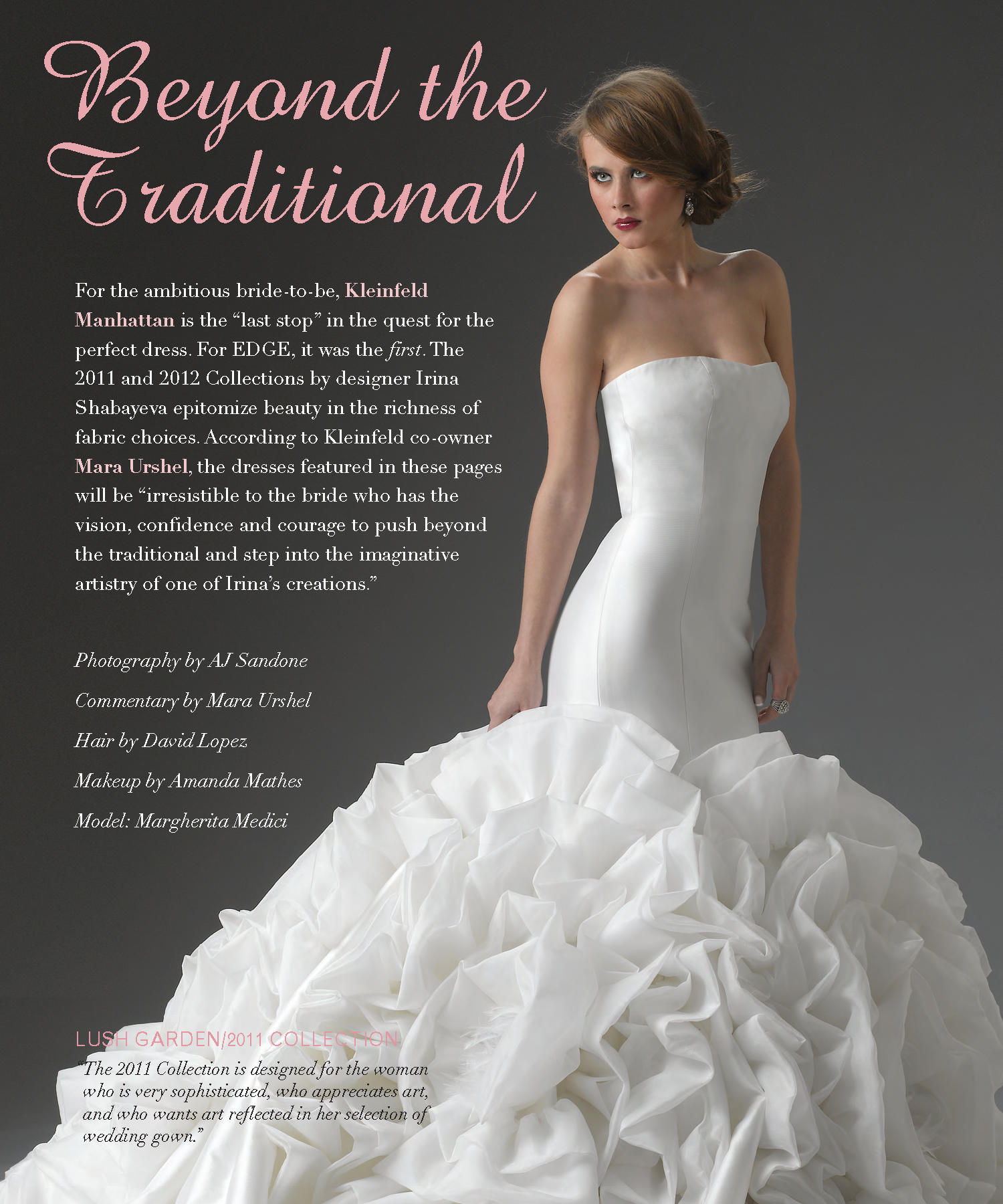

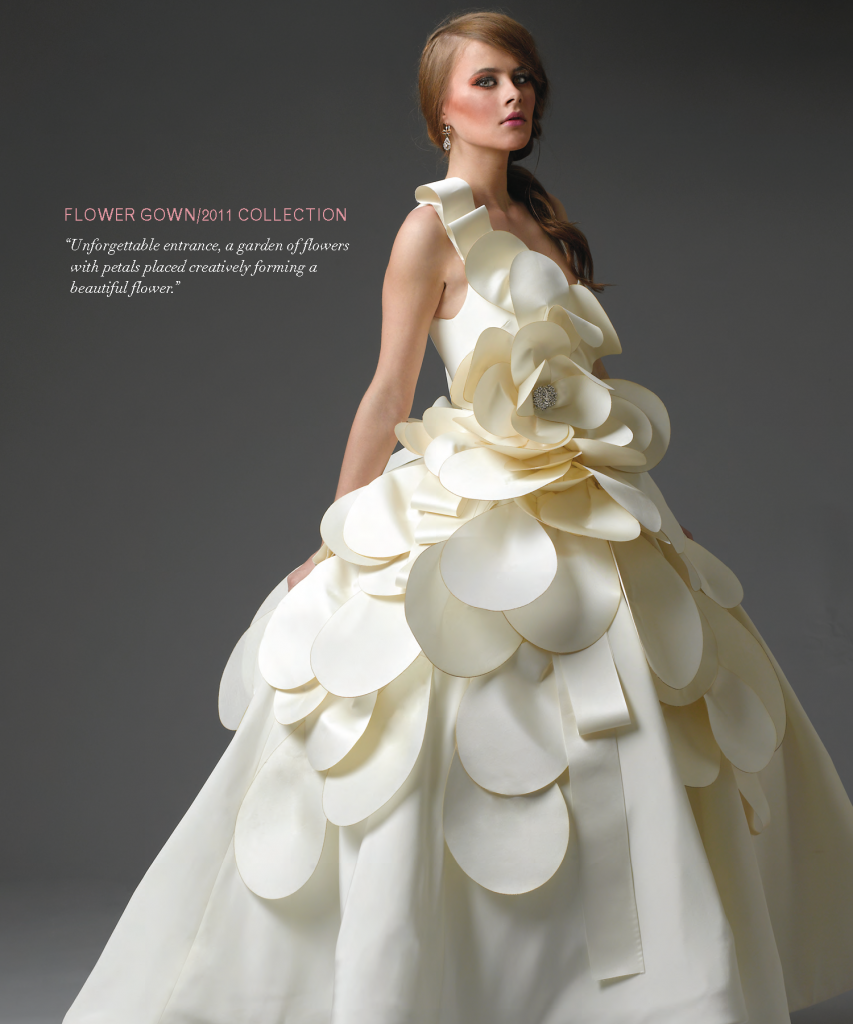
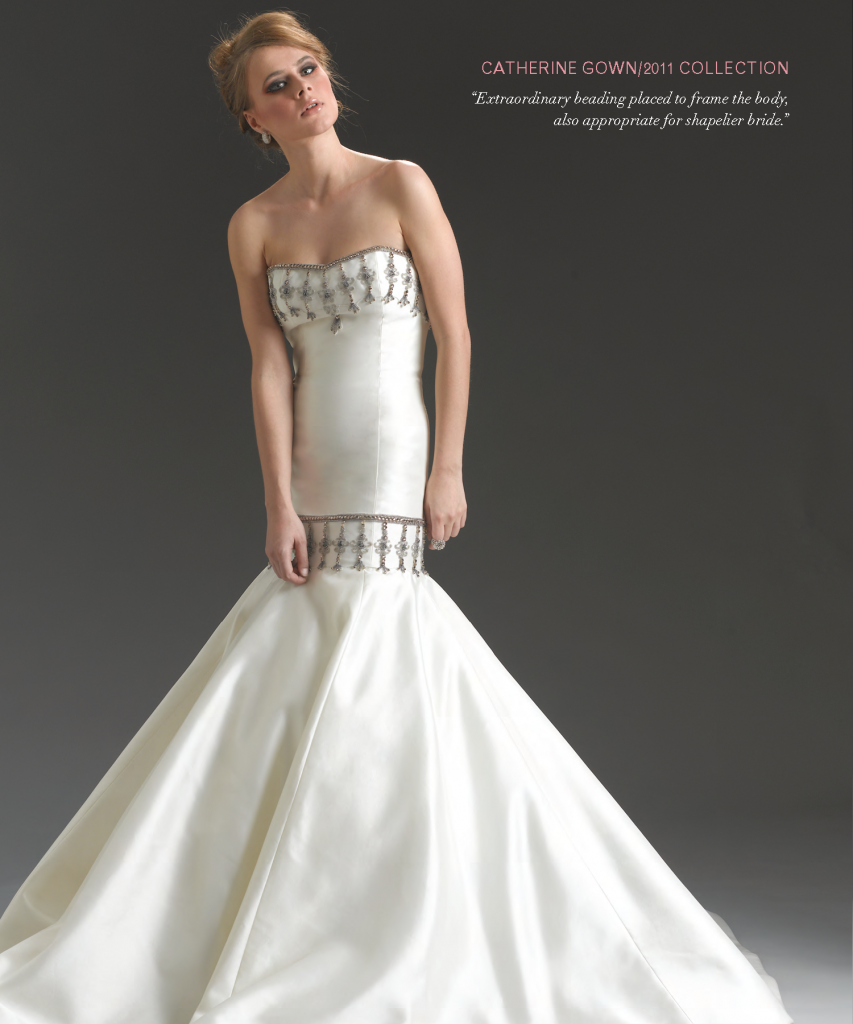


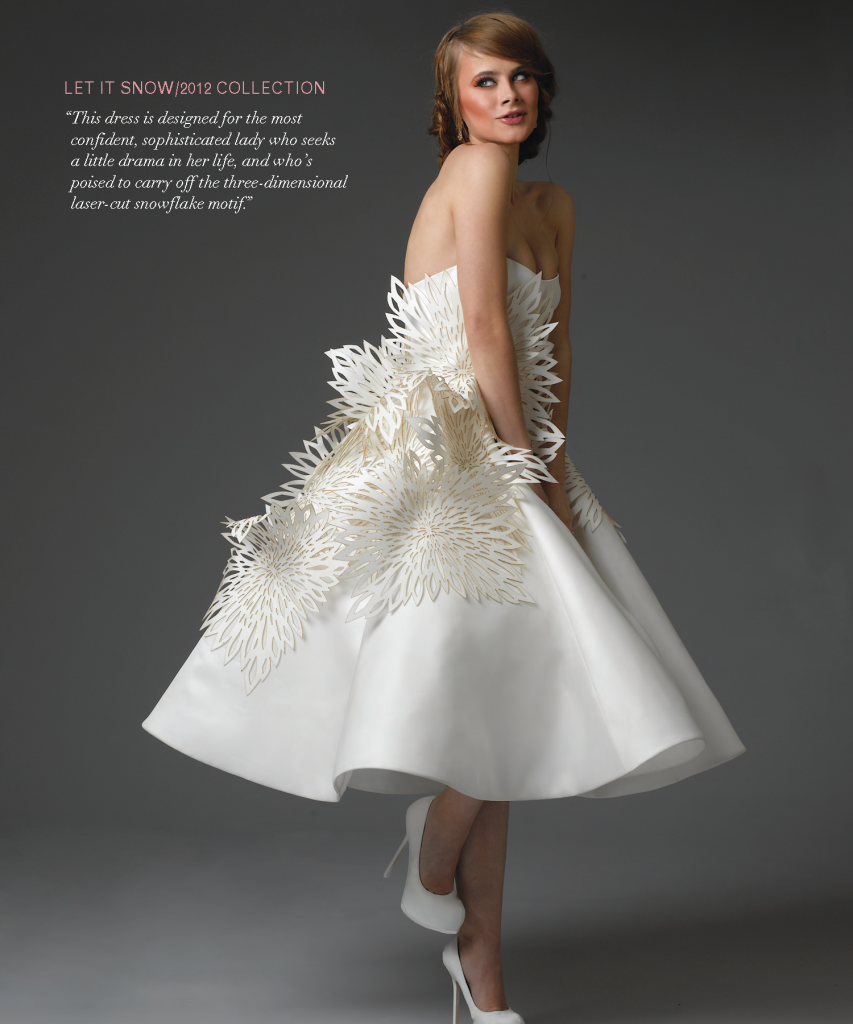
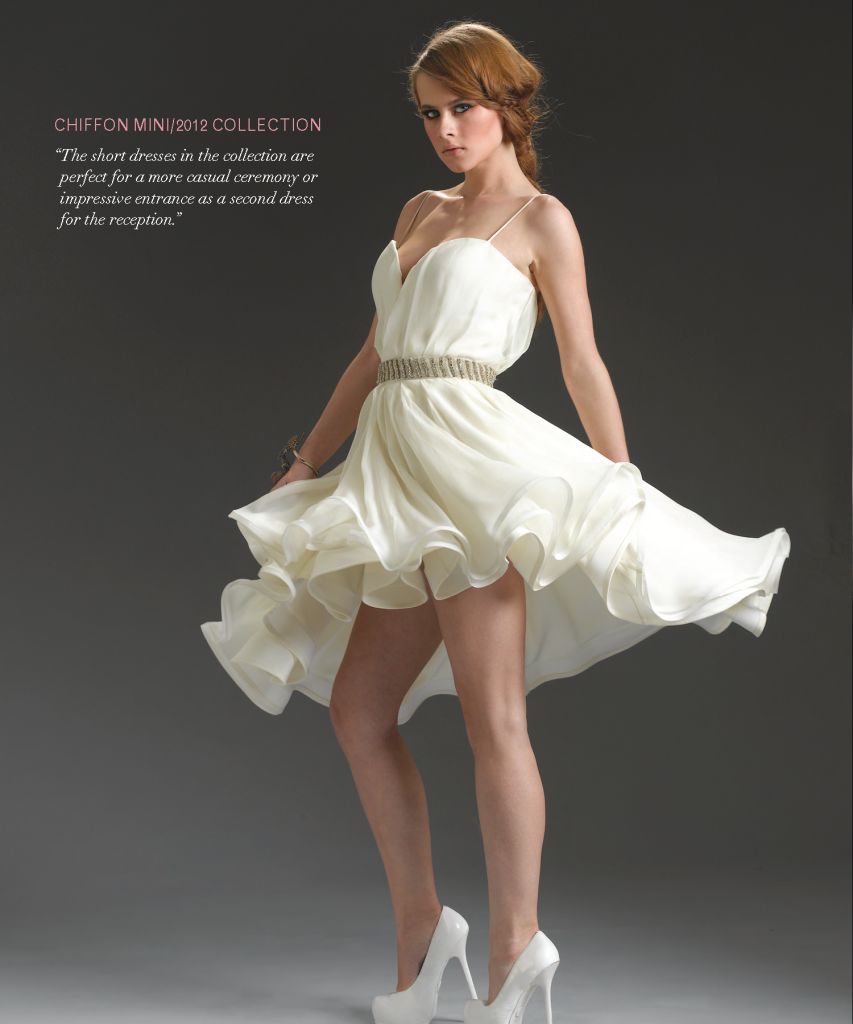
Fashion stylists are fast achieving celebrity status. Imagine a store staffed with them.
You know the old saying It’s not the destination, but the journey? Well, when it comes to fashion, believe me, it’s the destination. The journey? A mere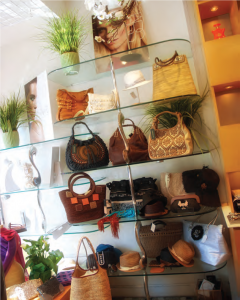 afterthought. Which explains why well-dressed women think nothing of devoting their most precious commodity—the better part of a day—to visit a clothing Mecca called Coco Pari, with outposts in the hip little Monmouth County towns of Red Bank and Deal. Coco is the total package, offering head-to-toe fashion and, more importantly, a point of view you won’t find in any department store. Staffed by young fashionistas bubbling with style, ready to plug a customer in and cover her act from every angle, Coco Pari has created a new breed of saleswoman-meets stylist— a funky hybrid of fashion editor and best friend. Red Bank store manager Briana, Southern transplants Sophie and Faith, playful Lauren and eye-catching Lindsay literally live, eat and breathe fashion. By day, they are consulting with shoppers on silhouettes that flatter each woman’s unique personality and style. By night, they are out and about, texting back and forth about who’s wearing what. They know the trends and they are not afraid to tell customers what looks good, even if they might not be thinking along the same lines. The ladies at Coco Pari have that “it” factor, and it radiates and translates as they work with customers from the trenches to the cash register. What pleases them the most is simply helping women achieve perfection. In the spirit of full disclosure, I should point out that the saleswoman-as-stylist approach is not the main reason why regulars make the trek to Coco to get a fresh new take on their wardrobe each season. That honor goes to Kimberly Landau, the store’s sole accessory, ready-to-wear and evening couture buyer. The sexy, rocker-chic 36-year-old hand-picks and hand-trains each fashion assassin on her floor; she has established a powerhouse retail operation with fans and followers throughout the tri-state area. The ease with which the Coco Pari sales staff pulls outfits is somewhat deceptive. Landau often stays in the store past 2:00 a.m., merchandising like a madwoman, and then game-planning with the girls before the doors open each day. Everything is clean and clarified. Because Landau does the buy, Coco customers can be completely confident that they’re looking at the
afterthought. Which explains why well-dressed women think nothing of devoting their most precious commodity—the better part of a day—to visit a clothing Mecca called Coco Pari, with outposts in the hip little Monmouth County towns of Red Bank and Deal. Coco is the total package, offering head-to-toe fashion and, more importantly, a point of view you won’t find in any department store. Staffed by young fashionistas bubbling with style, ready to plug a customer in and cover her act from every angle, Coco Pari has created a new breed of saleswoman-meets stylist— a funky hybrid of fashion editor and best friend. Red Bank store manager Briana, Southern transplants Sophie and Faith, playful Lauren and eye-catching Lindsay literally live, eat and breathe fashion. By day, they are consulting with shoppers on silhouettes that flatter each woman’s unique personality and style. By night, they are out and about, texting back and forth about who’s wearing what. They know the trends and they are not afraid to tell customers what looks good, even if they might not be thinking along the same lines. The ladies at Coco Pari have that “it” factor, and it radiates and translates as they work with customers from the trenches to the cash register. What pleases them the most is simply helping women achieve perfection. In the spirit of full disclosure, I should point out that the saleswoman-as-stylist approach is not the main reason why regulars make the trek to Coco to get a fresh new take on their wardrobe each season. That honor goes to Kimberly Landau, the store’s sole accessory, ready-to-wear and evening couture buyer. The sexy, rocker-chic 36-year-old hand-picks and hand-trains each fashion assassin on her floor; she has established a powerhouse retail operation with fans and followers throughout the tri-state area. The ease with which the Coco Pari sales staff pulls outfits is somewhat deceptive. Landau often stays in the store past 2:00 a.m., merchandising like a madwoman, and then game-planning with the girls before the doors open each day. Everything is clean and clarified. Because Landau does the buy, Coco customers can be completely confident that they’re looking at the cherry picked “best of the best.” It’s the key to the Coco Pari experience. “Fashion really is about building confidence for women,” notes Landau, who loves to see women elevate themselves using her store as a workshop. “Coco Pari is not for people who want to stay under the radar. Many people come here with ‘friends’ who won’t give them an honest opinion, but my employees will give it to them straight—one hundred percent.” The actual shopping experience at Coco is difficult to capture in words. To me, it’s like tumbling down Alice’s rabbit hole into a decadent, bejeweled jackpot of Jimmy Choos, Herve Legers and Christian (!) Louboutins. It’s an animal print upholstered, crystallized toy box perfectly fitting for the innermost reaches of the feminine psyche. It’s nice to know that somewhere—in between Lacrosse games, pick-ups and drop-offs, charitable nights out on the town, and everything else that finds its way onto our overcrowded calendars—you can still find a fairy godmother like Kimberly to help women transform their mood, their minds and their hearts.
cherry picked “best of the best.” It’s the key to the Coco Pari experience. “Fashion really is about building confidence for women,” notes Landau, who loves to see women elevate themselves using her store as a workshop. “Coco Pari is not for people who want to stay under the radar. Many people come here with ‘friends’ who won’t give them an honest opinion, but my employees will give it to them straight—one hundred percent.” The actual shopping experience at Coco is difficult to capture in words. To me, it’s like tumbling down Alice’s rabbit hole into a decadent, bejeweled jackpot of Jimmy Choos, Herve Legers and Christian (!) Louboutins. It’s an animal print upholstered, crystallized toy box perfectly fitting for the innermost reaches of the feminine psyche. It’s nice to know that somewhere—in between Lacrosse games, pick-ups and drop-offs, charitable nights out on the town, and everything else that finds its way onto our overcrowded calendars—you can still find a fairy godmother like Kimberly to help women transform their mood, their minds and their hearts.
Editor’s Note: Vicki McDougal is a television producer and photographer who has been working in the fashion industry for more than 20 years. She snapped the photos for this feature. Coco Pari (cocopari.com) is located at 17 Broad Street in Red Bank and at 270 Norwood Avenue in Deal.
Summer is here. And attention must be paid!
For those of us fortunate enough to be renting a beach house—whether it be for a few days or a few weeks—there’s no sense investing those big bucks if you’re unwilling to spend a couple more to look your best when you hit the sand. Whether you’ll be making the scene with oceanfront cocktails, hitting a charity gala at that swanky beach club, or just having a family barbecue on the sand, here are some tips to make sure your endless summer has you looking as fabulous as possible. First rule of thumb: you don’t have to get a burn to grab a perfect tan. Physicians Formula Bronze Booster Self- Tanning Bronzing Veil ($15) is enriched with 100% natural oils. It hydrates, protects and helps regenerate the skin for a smooth, flawless finish. Mimicking the effects of a deeply hydrating body butter treatment, this formula is ideal for quenching sun- and wind parched dry skin. Don’t forget to still blend a little with your fingertips after applying to ensure a streak-free finish. This product will leave your skin looking naturally tan, not orange or streaked. It’s quality luxury, and most importantly, it’s safe. Secondly, toner is essential for healthy skin in a warm-weather climate. Yon-Ka Lotion PG Toner ($26) is pretty much as naturally perfect as it gets. It rehydrates dry skin with soothing, nutritious ingredients. This aromatic toning mist is designed for semi-oily skin. It refreshes, soothes, and equalizes, and the amazing scent makes it perfect for a midday
unwilling to spend a couple more to look your best when you hit the sand. Whether you’ll be making the scene with oceanfront cocktails, hitting a charity gala at that swanky beach club, or just having a family barbecue on the sand, here are some tips to make sure your endless summer has you looking as fabulous as possible. First rule of thumb: you don’t have to get a burn to grab a perfect tan. Physicians Formula Bronze Booster Self- Tanning Bronzing Veil ($15) is enriched with 100% natural oils. It hydrates, protects and helps regenerate the skin for a smooth, flawless finish. Mimicking the effects of a deeply hydrating body butter treatment, this formula is ideal for quenching sun- and wind parched dry skin. Don’t forget to still blend a little with your fingertips after applying to ensure a streak-free finish. This product will leave your skin looking naturally tan, not orange or streaked. It’s quality luxury, and most importantly, it’s safe. Secondly, toner is essential for healthy skin in a warm-weather climate. Yon-Ka Lotion PG Toner ($26) is pretty much as naturally perfect as it gets. It rehydrates dry skin with soothing, nutritious ingredients. This aromatic toning mist is designed for semi-oily skin. It refreshes, soothes, and equalizes, and the amazing scent makes it perfect for a midday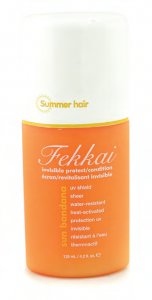
post-beach lift. Thirdly, any summer house inhabitant worth his or her weight in Mimosa needs a quality moisturizer with an SPF. Neutrogena Oil Free Moisturizer is a modern classic that knows no bounds. It’s sheer, odorless, and packs an SPF 30 punch. Not only will it protect you from UV rays, it’ll keep your wallet intact at around $10 a bottle. I recommend reapplying as needed whenever you start to feel dryness. For the same affect on your hair, Frederic Fekkai’s Summer Hair Sun Bandana ($20) is heat-activated to protect hair follicles from the harshness of sun, saltwater and chlorine. Locking in conditioning elements, Sun Bandana is also oil-free, which is a total rarity in the hair mask product world. And it smells amazing. As for the fellas, don’t be swayed by what your buddies tell you! Harsh sun, salt water and chlorine hold the same dangers for your skin and hair as they do for the ladies, so don’t be afraid to moisturize in the manliest way possible. Jack Black’s 16 oz. Beard Lube Conditioning Shave cream ($32) is perfect for summer. It’s a light, non-invasively fragrant, pre-shave oil, shave cream and skin conditioner in one.
KISSY–KISSY No summer would be complete without a little romance, right? That being said, it’s important not to neglect your lips. The more tender the skin, the more vulnerable it is to sun damage. In this instance, it’s best to just stick with a classic. Smith’s Minted Rose Balm ($7) is pretty much as good as it gets. This balm is as smooth as Carmex without the globby, heavy feel. Incidentally, it also manages to taste refreshing and sexy at the same time, which makes it a favorite of surfers and supermodels alike. Speaking of surfers and supermodels, every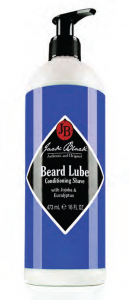 great summer share necessitates at least one fabulous fete. Great bones make for a great home, for a little extra midsummer’s night flair, fill your house with gardenias and keep bowls of fresh lemons and limes on every table (a Martha Stewart secret). You’ll be pleasantly surprised at how far a little aromatherapy can take a first meeting. The next morning, en route to the beach, revisit the citrus and scrape the skin gently with your
great summer share necessitates at least one fabulous fete. Great bones make for a great home, for a little extra midsummer’s night flair, fill your house with gardenias and keep bowls of fresh lemons and limes on every table (a Martha Stewart secret). You’ll be pleasantly surprised at how far a little aromatherapy can take a first meeting. The next morning, en route to the beach, revisit the citrus and scrape the skin gently with your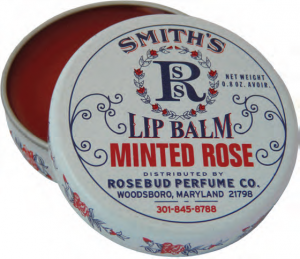 fingernails. Sounds funny, right? The Ancient Romans relied heavily on oranges, pomegranates, and other succulent and aromatic fruits to spice up any and all get-togethers. And if anyone knew how to party, it was that lot. However, while it’s always fun to embrace a When in Rome mentality, moderation is the order of the day, so sparingly massage the essence into your hair and body. You’ll be making new friends in no time at all. As the days get longer, remember that every carefree, sunny day is to be enjoyed to its fullest, and each balmy night that follows deserves a steamy story. Hopefully, between looking the part of a bronzed, summertime beauty—with help from the sun, sand, and science—this will be the most fantastic and fruitful of all your summer escapes.
fingernails. Sounds funny, right? The Ancient Romans relied heavily on oranges, pomegranates, and other succulent and aromatic fruits to spice up any and all get-togethers. And if anyone knew how to party, it was that lot. However, while it’s always fun to embrace a When in Rome mentality, moderation is the order of the day, so sparingly massage the essence into your hair and body. You’ll be making new friends in no time at all. As the days get longer, remember that every carefree, sunny day is to be enjoyed to its fullest, and each balmy night that follows deserves a steamy story. Hopefully, between looking the part of a bronzed, summertime beauty—with help from the sun, sand, and science—this will be the most fantastic and fruitful of all your summer escapes.
Best-selling novelist Kristin Hannah discusses her new book…and the challenges, choices and rewards of parenting a high school senior.
Timing is everything. Indeed, in her latest foray into the women’s fiction market, New York Times bestselling author Kristin Hannah explores the complex 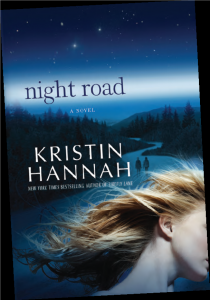 dynamic created when a family with high school- aged twins opens its home to a disadvantaged teenager. Night Road unfolds during a time in the twins’ lives that challenges even the most steadfast parent: senior year. This is the story of the Farradays—mother Jude, father Miles and teens Zach and Mia—and Lexi Ball, a former foster child. When Lexi moves into the Farradays’ small, close-knit community, she quickly becomes Mia’s best friend—and, eventually, the object of Zach’s affections. But the inseparable trio’s world is shattered when a reckless decision tears the Farraday family apart, changes the entire course of Lexi’s life, and grief forever transforms Jude’s ability to be a mother. The book raises profound questions about the resilience of the human heart and the courage it takes to forgive through the haunting story of a family shattered by tragedy, and their struggle to put the pieces back together. Hannah didn’t have to look far for the inspiration she needed to infuse her book with the emotional turmoil parents experience when teenagers first begin vying for independence. She was inspired to write Night Road after experiencing the ups and downs of her own son’s senior year. “We’ve always had a really close relationship, and he’s a really good kid, but we suddenly found ourselves battling constantly about the decisions he was making and the dangers waiting out there in the world for him,” she says. “I didn’t realize until quite some time later that I didn’t sleep much that year…and I started writing Night Road when I could look back and reflect upon that stressful time in the life of any family.” Night Road’s powerful maternal force, Jude, in many ways epitomizes the term “helicopter parent” for the micromanaging role she plays in her twins’ lives. Hannah says her most recent book is much like the 2008 novel Firefly Lane (which explores the friendship between two women as they pursue the often opposing goals of fame and family) in that the story was largely drawn from her own personal experiences. “The challenges, the choices, and the questions that arose during my son’s senior year of high school really informed the writing of Night Road,” she explains. “There’s a lot of myself in the character of Jude—but then there’s a little bit of me in all of my characters. What writers bring
dynamic created when a family with high school- aged twins opens its home to a disadvantaged teenager. Night Road unfolds during a time in the twins’ lives that challenges even the most steadfast parent: senior year. This is the story of the Farradays—mother Jude, father Miles and teens Zach and Mia—and Lexi Ball, a former foster child. When Lexi moves into the Farradays’ small, close-knit community, she quickly becomes Mia’s best friend—and, eventually, the object of Zach’s affections. But the inseparable trio’s world is shattered when a reckless decision tears the Farraday family apart, changes the entire course of Lexi’s life, and grief forever transforms Jude’s ability to be a mother. The book raises profound questions about the resilience of the human heart and the courage it takes to forgive through the haunting story of a family shattered by tragedy, and their struggle to put the pieces back together. Hannah didn’t have to look far for the inspiration she needed to infuse her book with the emotional turmoil parents experience when teenagers first begin vying for independence. She was inspired to write Night Road after experiencing the ups and downs of her own son’s senior year. “We’ve always had a really close relationship, and he’s a really good kid, but we suddenly found ourselves battling constantly about the decisions he was making and the dangers waiting out there in the world for him,” she says. “I didn’t realize until quite some time later that I didn’t sleep much that year…and I started writing Night Road when I could look back and reflect upon that stressful time in the life of any family.” Night Road’s powerful maternal force, Jude, in many ways epitomizes the term “helicopter parent” for the micromanaging role she plays in her twins’ lives. Hannah says her most recent book is much like the 2008 novel Firefly Lane (which explores the friendship between two women as they pursue the often opposing goals of fame and family) in that the story was largely drawn from her own personal experiences. “The challenges, the choices, and the questions that arose during my son’s senior year of high school really informed the writing of Night Road,” she explains. “There’s a lot of myself in the character of Jude—but then there’s a little bit of me in all of my characters. What writers bring
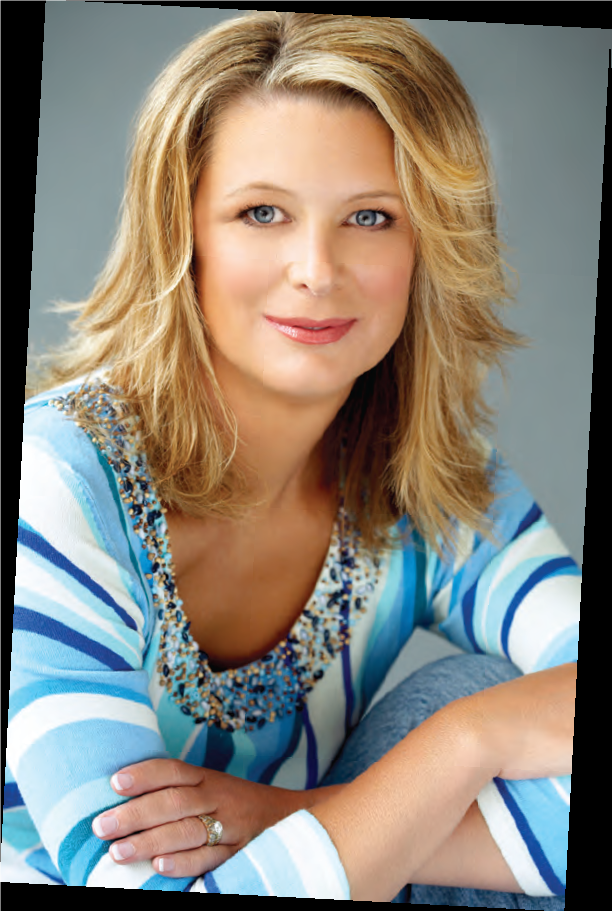
Photo courtesy of Deborah Feingold
to the table is a collection of our experiences and world views, our moral codes and philosophical beliefs…and all of that is often tangled up within our characters.” Like Jude, Hannah’s own personal journey was fueled by the influence of motherhood. She originally had her sights set on becoming an attorney, but when her mother was diagnosed with cancer during her final year of law school, the pair began working on a novel together. Though her mom always insisted that Hannah was destined to be a writer, she didn’t return to the uncompleted manuscript again until she was placed on bed rest during her own pregnancy, desperate for an outlet to pass the time. Jude Farraday’s tendency to always put her children’s needs before her own probably mirrors Hannah’s desire to keep motherhood the utmost priority, even if it meant putting her own writing aspirations on the backburner from time to time as she established her career as a fiction author. “I was in this interesting position of being a working mom who stays at home,” she recalls. “It did require a lot of balancing, but quite honestly I’ve always put motherhood first. As my son got older he needed me around less and less, so I’ve been focusing on my career a lot more in the past ten years.” Indeed, Hannah had already penned 18 novels, most of which delve deep into the complex relationships between women (friends, sisters, mothers, daughters) and how they guide our lives. “These are the relationships that determine how we’re going to live and who we’re going to be, and that has always fascinated me,” she says. Night Road explores the friendship between two teenaged girls and, eventually, the all-consuming passion of first love. Still, Hannah remains true to the maternal character of Jude by repeatedly averting the reader’s attention to her classic inner struggle: what it means to be a good mother. She provokes readers to reflect upon the decisions they make as parents, and how to strike that delicate balance between protecting your children and helping them spread their wings. “It’s a coming-of-age story about kids trying to break free at 18, but it’s also about how we, as mothers, try to keep our children safe,” Hannah says, adding that Night Road really is about motherhood. “Writing it did give me a lot of time to think about the decisions and challenges that 18-year-olds and their parents face. I hope the book could spark a discussion between parents and their kids.” The best piece of advice Hannah has for moms? “Remain open and honest,” she says, and “create an environment where conversation can occur.”
Editor’s Note: Special thanks to Tanya Farrell, Susan Belfer and Nicole Rotunda. Night Road was released this spring by St. Martin’s Press.


